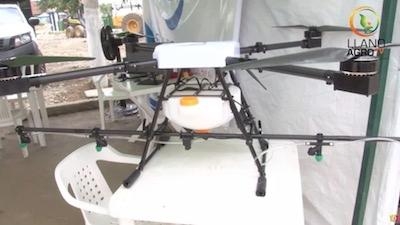Wed, Aug 22, 2018
Ten Drones Being Tested In Nariño Province
The Colombian government is testing a fleet of 10 drones to destroy coca plants that are used in the production of cocaine.

Drone DJ relays a report from the Wall Street Journal which indicates that the new President of Colombia, Iván Duque, prefers using drones over manned aircraft to protect neighboring crops from damage.
The tests are being conducted in the southwestern portion of Nariño province. The drones carry the herbicide Glyphosate, a defoliant, and spray the coca plants with far greater accuracy than could be achieved using more traditional methods. The previous President of Colombia, Juan Manuel Santos, had halted spraying by 14 crop duster airplanes after local farmers filed lawsuits who were concerned about their health. Glyphosate has been linked to some cancers by the World Health Organization.
The U.S. EPA has said that glyphosate is "unlikely" to cause cancer. The chemical has been part of a $10 billion foreign aid package called "Plan Colombia". Use of the chemical reduced the country's coca fields from 470,000 acres in 2001 to 193,000 acres in 2012. But by 2017, the acreage had again increased 160 percent to 516,000 acres.
The drones have been provided by Fumi Drones SAS. German Huertas, director of operations at Fumi Drone says that the aircraft can eliminate about 90 percent of the crops on every acre of coca plants. They also fly lower to the ground, and do not pose a safety hazard to pilots flying close to the ground, Huertas said. The company is also training local police to fly the aircraft.
The downside is that the drones carry a much smaller load of the defoliant than a crop duster, and police must cordon off an area to be sprayed to prevent local farmers from being exposed or cocaine manufacturers from shooting them out of the air. There are also a large number of landmines buried in many regions from a long rebel conflict in Colombia, which can pose additional threats to soldiers and drone pilots.
(Image provided by Llano AgroTV)
More News
From 2023 (YouTube Version): Legacy of a Titan Robert (Bob) Anderson Hoover was a fighter pilot, test pilot, flight instructor, and air show superstar. More so, Bob Hoover was an i>[...]
Get The Latest in Aviation News NOW on Instagram Are you on Instagram yet? It's been around for a few years, quietly picking up traction mostly thanks to everybody's new obsession >[...]
Aero Linx: B-52H Stratofortress The B-52H Stratofortress is a long-range, heavy bomber that can perform a variety of missions. The bomber is capable of flying at high subsonic spee>[...]
Altimeter Setting The barometric pressure reading used to adjust a pressure altimeter for variations in existing atmospheric pressure or to the standard altimeter setting (29.92).>[...]
"Knowing that we play an active part in bettering people's lives is extremely rewarding. My team and I are very thankful for the opportunity to be here and to help in any way we ca>[...]
 Classic Aero-TV: Remembering Bob Hoover
Classic Aero-TV: Remembering Bob Hoover ANN FAQ: Follow Us On Instagram!
ANN FAQ: Follow Us On Instagram! ANN's Daily Aero-Linx (05.15.24)
ANN's Daily Aero-Linx (05.15.24) ANN's Daily Aero-Term (05.15.24):Altimeter Setting
ANN's Daily Aero-Term (05.15.24):Altimeter Setting Aero-News: Quote of the Day (05.16.24)
Aero-News: Quote of the Day (05.16.24)



